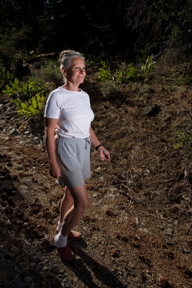Preventing and Treating Osteoporosis
Your hip bone's connected to your leg bone...
Your leg bone's connected to your knee bone...
Your knee bone's connected to your shin bone...
But what happens when these bones become weak, brittle and break? We have over 200 bones that make up our skeletal system. These bones function to move, support and protect the various organs of the body, produce red and white blood cells and store minerals.
Bones are at their strongest at around age thirty and thereafter their strength and integrity begins to decline. Therefore a lot of what you do in your younger years determines the strength of your bones in your later years. Maintaining bone strength is extremely important as you age, to prevent osteoporosis, when your bones become weak and brittle. Balancing your hormones when you undertake my natural weight loss program (MassAttack) or fertility enhancing program (Bump Fertility) also helps to put you on the right track to maintaining your bone density. But please also consider the other risk factors for osteoporosis listed below. Lifestyle changes made now may assist in maintaining bone density as you age and prevent the onset of osteoporosis.
What is osteoporosis?
Osteoporosis is a serious condition in which the bones become brittle and fragile, leading to a higher risk of fractures than in normal bone. This occurs when bones lose minerals, such as calcium, more quickly than the body can replace them. This leads to a loss of bone thickness i.e. a loss of bone mass or density.
In normal bone, there is constant remodelling of bone. Bone is resorbed by osteoclast cells, and then rebuilt by osteoblast cells. When these two processes work in balance and in harmony, bones remain healthy and strong. In osteoporosis however, there is excessive bone resorption and inadequate formation of new bone.
As the bones become thinner and less dense, even a minor bump or accident can cause serious fractures. Osteoporotic fractures are those that occur in situations where healthy people would not normally break a bone.
Osteoporosis - a silent disease on the rise
Osteoporosis is one of the world's most common and debilitating diseases. The sites most frequently affected by osteoporosis are bones in the hip, spine, wrist, ribs, pelvis and upper arm, although any bone can be affected by osteoporosis. Osteoporosis is often called a "silent disease", as usually there are no signs or symptoms that bones are thinning until a fracture occurs.
Recent statistics show that in Australia, 1 in 2 women and 1 in 3 men over 60 years of age will have an osteoporotic fracture in their lifetime. In fact, every 8 minutes, someone is admitted to an Australian hospital with an osteoporotic fracture. This is expected to rise to one every 3 - 4 minutes by the year 2021, as our population ages.
Risk factors for osteoporosis
Hormonal factors strongly determine the rate of bone resorption which is why osteoporosis is most common in women after menopause. There are also a number of other factors that increase your risk of developing osteoporosis.
Hormonal factors that can contribute to reductions in bone density include:
- Lack of oestrogen, causing increased bone resorption and reduced deposition of new bone
- Reduced testosterone levels i.e. andropause
- Chronically elevated cortisol levels
- Excessive production of parathyroid hormone.
Other factors that can increase your risk of developing osteoporosis include:
- Advanced age in both men and women
- Physical inactivity - bone remodelling occurs in response to physical stress, therefore physical inactivity can lead to significant bone loss
- Heavy metal toxicity - there is a strong association between cadmium and lead exposure and bone disease
- Inflammatory autoimmune conditions, such as rheumatoid arthritis, ankylosing spondylitis, and systemic lupus erythematosus, increase risk of osteoporosis
- Excess alcohol intake (greater than two standard drinks per day)
- Tobacco smoking (smoking inhibits the activity of osteoblasts)
- High soft drink consumption. Studies indicate that soft drinks (many of which contain phosphoric acid) may increase risk of osteoporosis
- Eating a high acid-load diet and/or having an acidic system. Essentially, having an acidic system will increase calcium excretion as the calcium is used by the body to neutralise the acid.
- Low dietary intake of protein is also associated with lower peak bone mass
- Low dietary intake of key micronutrients, i.e. calcium, vitamin K and vitamin C
- Vitamin D deficiency which leads to impaired bone deposition.
Nutrients to build bone
Calcium is a vital mineral required for the formation of strong bones as it helps increase the density and strength of bones. Calcium can be found in some foods, particularly dairy and green, leafy vegetables. However, many people do not get their recommended dietary intake (RDI) of calcium from their diet. A random sample of Australian women aged 55-92 years found they had a mean dietary calcium intake of 646 mg/day, well below the Australian recommended daily intake (RDI) for this age group of 1000 mg/day. Fortunately, if you are not getting enough calcium from your diet, calcium can be taken in the form of a natural supplement.
Do you know what the best form of calcium is?
If you need to take a calcium supplement, keep in mind that not all calcium supplements are created equal. Microcrystalline hydroxyapatite is a form of calcium shown to be superior to other forms of calcium. This form of calcium has been shown to be very well absorbed and highly effective in the management of osteoporosis. As well as calcium, microcrystalline hydroxyapatite also contains all the natural elements of healthy bone, including silica, boron, type 1 collagen, zinc, manganese, copper, and the all-important GAGs (glycosaminoglycans). GAGs are proteins upon which bone tissue is built, and are not present in other types of calcium supplements.
Other nutrients
As well as microcrystalline hydroxyapatite, the following herbs, vitamins and minerals also help to keep your bones healthy and strong:
- Epimedium is a herb shown to enhance bone strength, by stimulating the activity of the cells that are responsible for bone formation.
- Vitamin D is required for the absorption of calcium and phosphorus. It is necessary for the proper growth and development of bones.
- Magnesium is an important mineral for the growth and strength of bone. Correct levels of magnesium are needed to ensure the proper utilisation of calcium in the growth of bone tissue.
Helpful dietary and lifestyle tips
As well as supplements to reduce the risk of developing osteoporosis here are some simple diet and lifestyle changes that you can make:

- Weight-bearing exercise is required to maintain adequate bone density and strength.
- Diet can be optimised by reducing intake of pro-inflammatory foods (saturated fats, dairy, etc).
- Increased intake of fresh vegetables, whole grains and essential fatty acids is vital to provide essential nutrients.
- Foods high in essential fatty acids such as oily fish and nuts/seeds should be emphasised.
- Minimally processed diet, rich in antioxidants, phytonutrients and bioflavonoids can be helpful.
- Protein is essential for connective tissue support, and should be consumed regularly.
- Decrease intake of caffeine, alcohol and salt
- The maintenance of a proper acid-alkaline base ratio is important for good health and ensures that calcium absorption is maximised.
- Excess consumption of dairy products causes acidification, which leaches calcium from the system. Better sources of calcium are almonds, buckwheat, egg yolk, green leafy vegetables and sardines and, in fact, milk products should be avoided.
- Reduce your intake of soft drinks.
- Adequate sun exposure (i.e. just 10-15 minutes most days) or supplementation with vitamin D is important.
- Quit smoking.
 |
Want to know more?
Why is the MassAttack Natural Health and Weight Loss Program different?
What will the MassAttack Natural Health and Weight Loss Program do for YOU?
What Does My Natural Health and Weight Loss Program Include?

